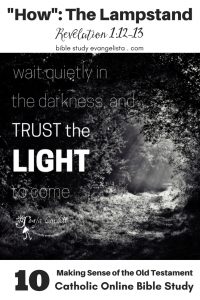Episodes

Monday Jun 11, 2018
Monday Jun 11, 2018

Notes and References
Exodus 25:31-40, The golden lampstand, or menorah, in the tabernacle
Exodus 27:20-21, Perpetual light
Leviticus 24:3-4, The priests kept the wicks trimmed, the oil topped, and the lamps burning before the Lord continuously.
Exodus 28:29-30, Urim and Thummim in the HIgh Priest’s breastplate of judgment. Urim = “Lights” and Thummim = “Perfect Truths” both superlative plural
- Sirach 45:10, together the names mean something similar to “Perfect Knowledge.”
- Numbers 27:21, used to consult God about His selection of leaders
- 1 Samuel 14:41, used to determine guilt or innocence
- Ezra 2:63, used to determine God’s will regarding returning captives
Other occurrences of “light” in the Old Testament
- Genesis 1:1-5 – light of creation
- Exodus 10:21-23 – Egyptian plague of darkness in which only the Israelites had light
- Exodus 13:17-22 – pillar of cloud and fire
- Psalm 27:1 – the Lord is my Light and my salvation, or “saving light”
- Isaiah 60:19 – “the Lord will be to you an everlasting light”
- Job 29:3 – light in the darkness
- Micah 7:8 – “God will be a light to me.”
John 8:12-59, In the Old Testament, light was synonomous with God’s presence, so when Jesus said “I am the Liight of the world,” they understood He was claiming to be God.
John 7:2, Jesus made this claim at the Feast of Tabernacles. The first evening of the festival was called the “Illumination of the Temple” in which four great lampstands were set ablaze in the temple to symbolize the presence of God among them in the pillar of light through the wilderness.
John 1:1-14, Christ—Word and Light
Magisterium
Exodus 18:13-27, Jethro counsels Moses to form a tribunal to assist him in adjudicating for the people. Later, this judgment seat came to be known as The Chair of Moses, and the tribunal the Sanhedrin Court (Numbers 11:16-17).
Matthew 23:2, The Chair of Moses was a phrase used to signify the place of authority that the Scribes and Pharisees occupied in interpreting The Law and exercising authority over the Jewish people. Although they had become corrupt and spiritually dead, Jesus upheld their office of authority as a matter of obedience to God. Later, it because the Chair of Peter, cathedra.
Isaiah 22:15-25, To Peter, Jesus gave the “keys” of administrative and governing responsibilities for his “house,” established him on a glorious “seat” (throne or chair) from which he would adjudicate (“open and shut”), and made him a “father” to his people (pope, meaning papa): “You are Peter [meaning rock] and upon this rock I will build my church…” ( Matt 16:17-19). The Church of history fulfills Isaiah’s prophecy and upholds the office of Peter’s chair
Revelation 1:12-13, The seven lampstands surrounding Jesus in the heavenly temple depict Jesus at the center of the institutional, Catholic priesthood. In the same way, the same seven lampstands radiating outwardly from the Light of the World depict the whole of the historical Church, led by the episcopacy, as the sacred illumination of the world.
CCC 89: “There is an organic connection between our spiritual life and the dogmas. Dogmas are lights along the path of faith; they illuminate it and make it secure. Conversely, if our life is upright, our intellect and heart will be open to welcome the light shed by the dogmas of faith.”


No comments yet. Be the first to say something!